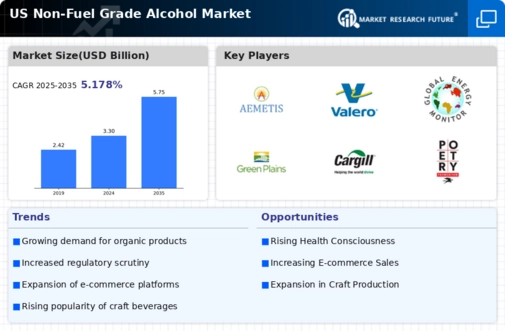The non fuel grade alcohol market exhibits a dynamic competitive landscape characterized by innovation, strategic partnerships, and a focus on sustainability. Key players such as Bacardi Limited (US), Diageo plc (GB), and Constellation Brands, Inc. (US) are actively shaping the market through various strategic initiatives. Bacardi Limited (US) emphasizes product innovation and sustainability, aiming to reduce its carbon footprint while expanding its premium offerings. Diageo plc (GB) focuses on digital transformation and consumer engagement, leveraging technology to enhance brand loyalty and streamline operations. Constellation Brands, Inc. (US) is strategically investing in localizing manufacturing to optimize supply chains and meet regional demands, thereby enhancing its competitive positioning.
The market structure appears moderately fragmented, with several key players exerting considerable influence. Business tactics such as localizing manufacturing and optimizing supply chains are prevalent among these companies, allowing them to respond swiftly to market changes and consumer preferences. The collective influence of these major players fosters a competitive environment where innovation and operational efficiency are paramount.
In November 2025, Bacardi Limited (US) announced a partnership with a leading technology firm to develop a new line of eco-friendly packaging solutions. This strategic move underscores Bacardi's commitment to sustainability and positions the company as a leader in environmentally responsible practices within the industry. The initiative is likely to resonate with environmentally conscious consumers, enhancing brand loyalty and market share.
In October 2025, Diageo plc (GB) launched an AI-driven marketing campaign aimed at personalizing consumer experiences across its portfolio. This innovative approach not only enhances customer engagement but also streamlines marketing expenditures, potentially leading to increased sales. The integration of AI into marketing strategies indicates a broader trend towards digitalization in the non fuel grade alcohol market.
In September 2025, Constellation Brands, Inc. (US) expanded its production facilities in the Midwest, a strategic decision aimed at meeting the growing demand for craft beverages. This expansion is expected to bolster the company’s supply chain efficiency and responsiveness to local market trends, thereby solidifying its competitive edge in a rapidly evolving landscape.
As of December 2025, the competitive trends in the non fuel grade alcohol market are increasingly defined by digitalization, sustainability, and technological integration. Strategic alliances are becoming more prevalent, allowing companies to leverage shared resources and expertise. The shift from price-based competition to a focus on innovation, technology, and supply chain reliability is evident, suggesting that future competitive differentiation will hinge on these factors.


















Leave a Comment